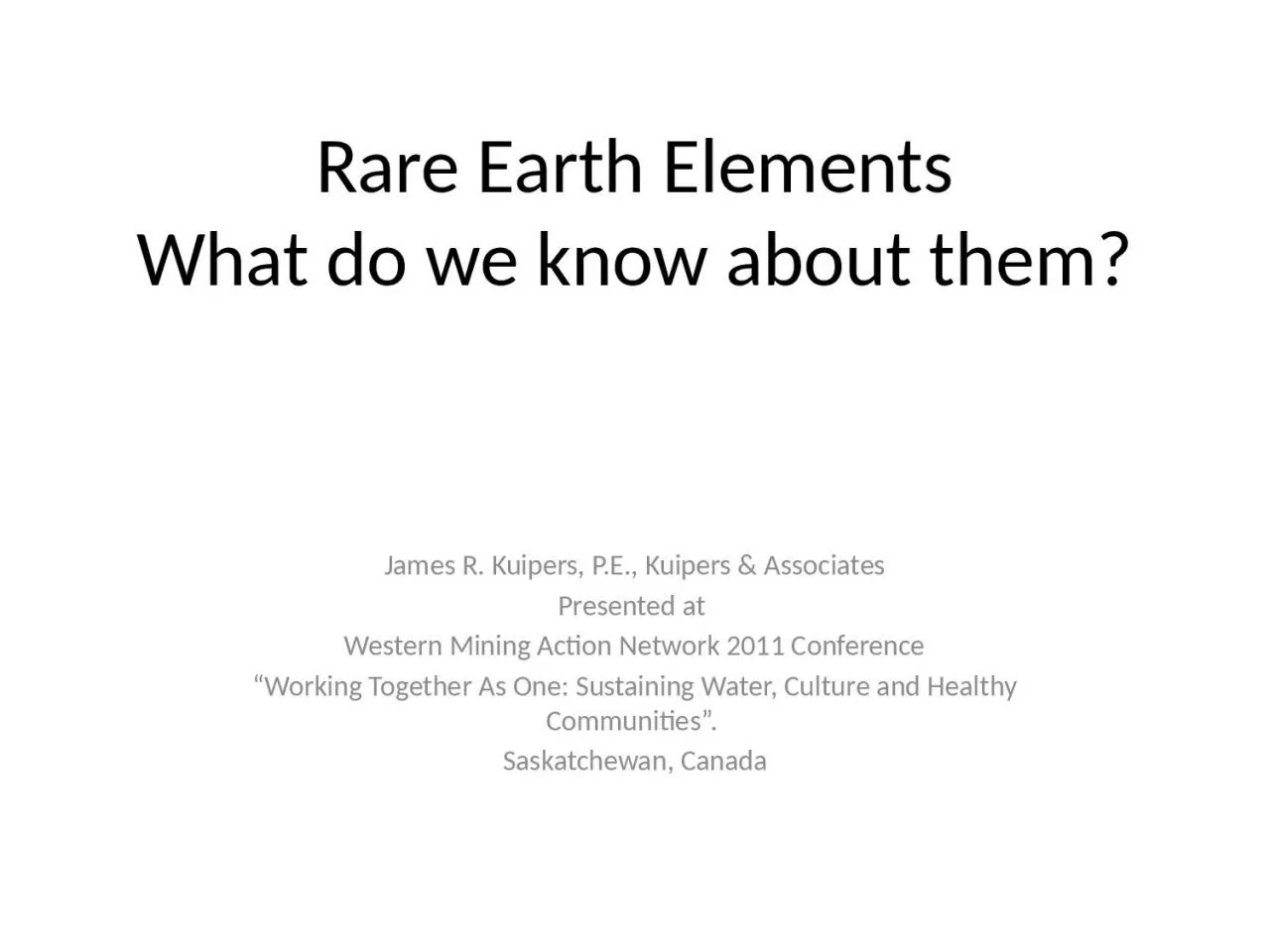

James R Kuipers PE Kuipers amp Associates Presented at Western Mining Action Network 2011 Conference Working Together As One Sustaining Water Culture and Healthy Communities Saskatchewan Canada ID: 1024579
Download Presentation The PPT/PDF document "Rare Earth Elements What do we know abou..." is the property of its rightful owner. Permission is granted to download and print the materials on this web site for personal, non-commercial use only, and to display it on your personal computer provided you do not modify the materials and that you retain all copyright notices contained in the materials. By downloading content from our website, you accept the terms of this agreement.
1. Rare Earth ElementsWhat do we know about them?James R. Kuipers, P.E., Kuipers & AssociatesPresented at Western Mining Action Network 2011 Conference“Working Together As One: Sustaining Water, Culture and Healthy Communities”. Saskatchewan, Canada
2. Rare Earth ElementsWhat Are They?The 30 rare earth elements are composed of the lanthanide and actinide series. One element of the lanthanide series and most of the elements in the actinide series are called trans-uranium, which means synthetic or man-made. 17 common rare earth elements found in nature: cerium, dysprosium, erbium, europium, gadolinium, holmium, lanthanum, lutetium, neodymium, praseodymium, samarium, terbium, thulium, ytterbium, yttrium, ferrocerium, monazite, bastnasite, mischmetal
3. Rare Earth ElementsPresent and Future UsesEstimated 2009 distribution of rare earths by end use, in decreasing order, was as follows (USGS 2011): chemical catalysts, 22%; metallurgical applications and alloys, 21%; petroleum refining catalysts, 14%; automotive catalytic converters, 13%; glass polishing and ceramics, 9%; rare-earth phosphors for computer monitors, lighting, radar, televisions, and x-ray-intensifying film, 8%; permanent magnets, 7%; electronics, 3%; and other, 3%. The trend appears to be for a continued increase in the use of rare earths in many applications, especially automotive catalytic converters, permanent magnets, and rechargeable batteries for electric and hybrid vehicles.
4. Rare Earth ElementsOccurrenceFirst discovered in the 19th Century in Sweden, they were believed to be some of the most uncommon elements. Rare-earths have been found to be relatively abundant in the Earth's crust, but rarely concentrated. High cost of extraction means that only deposits with high concentrations are likely to be developed.Rare earth minerals are usually found in association with alkaline to peralkaline igneous complexes, in pegmatites associated with alkaline magmas and in or associated with carbonatite intrusives. Perovskite mineral phases are common hosts to rare earth elements within the alkaline complexes. Mantle derived carbonate melts also are carriers of the rare earths. Hydrothermal deposits associated with alkaline magmatism contain a variety of rare earth minerals.
5. Rare Earth ElementsMine Production and ReservesCountry/RegionMine ProductionReserves20092010TotalUnited States——13,000,000Australia——1,600,000Brazil55055048,000China129,000130,00055,000,000Commonwealth of Independent States——19,000,000India2,7002,7003,100,000Malaysia35035030,000Other countries——22,000,000World total (rounded)133,000130,000110,000,000USGS 2011
6. Rare Earth ElementsWorld ResourcesRare earths are relatively abundant in the Earth’s crust, but discovered minable concentrations are less common than for most other ores. U.S. and world resources are contained primarily in bastnäsite and monazite. Bastnäsite deposits in China and the United States constitute the largest percentage of the world’s rare-earth economic resources, while monazite deposits in Australia, Brazil, China, India, Malaysia, South Africa, Sri Lanka, Thailand, and the United States constitute the second largest segment. Apatite, cheralite, eudialyte, loparite, phosphorites, rare-earth-bearing (ion adsorption) clays, secondary monazite, spent uranium solutions, and xenotime make up most of the remaining resources. Undiscovered resources are thought to be very large relative to expected demand. A very large resource enriched in heavy rare-earth elements is inferred for phosphorites of the Florida Phosphate District. USGS 2011
7. Rare Earth ElementsFuture MinesExploration efforts to develop rare earths projects surged in 2010, and investment and interest increased dramatically. Economic assessments continued in North America at Bear Lodge in Wyoming; Diamond Creek in Idaho; Elk Creek in Nebraska; Hoidas Lake in Saskatchewan, Canada; Lemhi Pass in Idaho-Montana; and Nechalacho (Thor Lake) in Northwest Territories, Canada. Other economic assessments took place in other locations around the world, including Dubbo Zirconia in New South Wales, Australia; Kangankunde in Malawi; Mount Weld in Western Australia, Australia; and Nolans Project in Northern Territory, Australia.
8. Rare Earth ElementsMining, Processing and RefiningTypically mined by bulk tonnage open pit methodsHigher grade deposits could be mined undergroundMineral processing typically done on-site using flotation and gravity processing Other processes may also be applicableRefining is most difficult/toxic stepacid or alkaline leach methodsPyrometallurgyEnvironmental ImpactsTypical to hardrock mining (water, air, soil contamination)Strong association with deposit type (acid or alkaline)
9. Rare Earth ElementsEnvironmental ToxicityFew toxicological data are available compared to other elements (e.g. lead, cadmium, chromium, mercury, nickel, zinc, arsenic, selenium) for either human or other ecological receptorsSome suggestion of chronic exposure impacts and strong suggestion of impacts when exposed to compounds (metallurgical and chemical, possible ecological)Possible effects include:lung disease, liver disease, eye and skin irritation, other effects
10. Rare Earth ElementsConclusionsRare Earth mining will increase but is likely to occur in only limited circumstancesHigh grade and high tech with large funding requiredSector is highly vulnerable to promotions and scamsIn more suitable locations with good practices should be possible with minimal impactsPotential opportunity to work with industry?100% from reprocessed tailings and waste rock?Need more environmental dataHuman health impacts (workforce and local residents)Ecological impacts (aquatic life, wildlife, riparian)